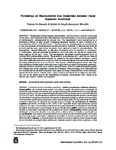Use este identificador para citar ou linkar para este item:
http://www.alice.cnptia.embrapa.br/alice/handle/doc/939307| Título: | Potential of macrophyte for removing arsenic from aqueous solution. |
| Autoria: | GUIMARÃES, F. P.  AGUIAR, R.   OLIVEIRA, J. A.   SILVA, J. A. A.   KARAM, D.   |
| Afiliação: | DECIO KARAM, CNPMS. |
| Ano de publicação: | 2012 |
| Referência: | Planta Daninha, Viçosa, MG, v. 30, n. 4, p. 683-696, 2012. |
| Conteúdo: | The potential of three aquatic macrophytes, Azoll caroliniana, Salvinia minima and Lemna gibba, was evaluated in this work aimed at selection of plants to be used in remediation of environments contaminated by arsenic (As). The experiments were carried out in a greenhouse during six days in pots containing Hoagland solution (¼ ionic strength) at As concentrations of 0.5; 2.5 and 5.0 mg L-1. The three species showed greater As accumulation as the concentration of the metalloid in solution increased. However, a reduction was detected in fresh and dry mass gain when the plants were exposed to high As concentrations. The macrophytes showed differences in efficiency of removal of As in solution. A. caroliniana, S. minima and L. gibba accumulated, on average, 0.130; 0.200; and 1.397 mg mDM-1, respectively, when exposed to 5.0 mg L-1 of As. The macrophytes absorbed a greater quantity of As in solution with low phosphate content. The greater As concentration in L. gibba tissues lowered the chlorophyll and carotenoid contents as shown by the high chlorosis incidence. Lemna gibba also exhibited a decrease in leaf size, with the total chlorophyll and carotenoid synthesis not being affected by As in A. caroliniana. This species exhibited purplish leaves with high concentration of anthocyanin, whose presence suggested association to phosphate deficiency. Marginal necrosis occurred on S. minima floating leaves, with the released daughter-plants not showing any visual symptoms during the treatment. The percentage of As removed from the solution decreased when the plants were exposed to high concentrations of the pollutant. Among the three species studied, only L. gibba could be considered an As hyper-accumulator. The use of this plant species for remediation of aquatic environments was shown to be limited and requires further investigation. |
| Thesagro: | Poluente Planta Aquatica |
| Palavras-chave: | Biorremediação Fitorremediação |
| Digital Object Identifier: | 10.1590/S0100-83582012000400001. |
| Tipo do material: | Artigo de periódico |
| Acesso: | openAccess |
| Aparece nas coleções: | Artigo em periódico indexado (CNPMS)  |
Arquivos associados a este item:
| Arquivo | Descrição | Tamanho | Formato | |
|---|---|---|---|---|
| Potentialmacrophyte.pdf | 1,72 MB | Adobe PDF |  Visualizar/Abrir |









